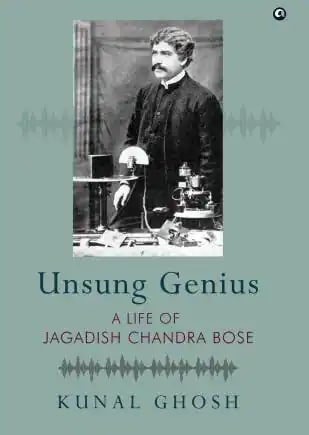This is by no means the first biography of Sir Jagdish Chandra Bose, one of India’s most admired scientists. There are many books about him – notably one by Patrick Geddes, a Scottish polymath, friend and admirer of Bose’s work.
The key message in Unsung Genius, however, revolves around Bose’s enthusiasm about bringing the study of science to the masses and his passion for scientific education and public lectures, despite his failing health.
The book embraces a healthy dose of controversy; the key question it raises is whether Marconi and Braun deserved the Nobel Prize for Physics in 1909! And now the sad part; Bose was not even in the running for it. The reasons for the same are explored in great detail – chances are you may feel extremely uneasy in some parts.

Five things that struck me:
1. If we consider the argument in the book that every attempt was made to sideline Bose’s genius – then the question arises – how many more geniuses suffered the same fate? The book explains that during the Victorian era, Calcutta was the capital of British India, and Bose, who lived there, faced discrimination. He was denied a fair salary upon his appointment as a college professor. The life of native scholars working under British rule was clearly difficult; to what extent did race and colonial prejudice interfere with a fair assessment of his research contributions?
2. It takes one genius to celebrate another – in 1900, Bose wrote a letter to Rabindranath Tagore from London and asked him ‘why do you write poetry in such a language that they are untranslatable into another tongue? However your short stories are a different matter, I shall publish them in this country.” Bose was very keen that his literary friend’s genius should be presented to the world. Tagore sent over Kabuliwala, Chutti, and Dan Pratidan, and soon enough, these stories were translated and made available to many more people.
3. Bose had many fans because his work was respected. A letter from an admirer in America says, “It seems to me imperative, that if we are going to have anything like the National Scientific movement in India at all, a parallel with Swamiji’s (Swami Vivekananda) religious movement, it is well to begin it now, while we have you to lead it. And so I want to start a fund for the foundation of an Indian lab and a fund to support the staff and pupils. If instead of fighting for political freedom, we can further a new school of Indian research and discovery, so that in 20 years much more will have been achieved really for freedom than… a direct attack.” The idea of connecting scientific progress to freedom is powerful. And the naivete of this letter and its pure intentions ironically brings to light the fact that prominent people connected with the nationalist movement were subjected to espionage during British times.
4. There is an interesting chapter ‘Marconi and Bose – The paths cross’ which begins with a letter by Silvanus P. Thompson, a professor of physics and fellow of the Royal Society. Thompson went on record that he was extremely displeased with Marconi’s practice of not acknowledging the work of predecessors. A heated exchange of letters between them is documented in the book.
5. The book acknowledges several unsung heroes – Maharajas, businessmen and well-wishers from India and abroad – who contributed funds to the development of early scientific research in India. The role of pure sciences in the development of humanity is a conversation we need to bring back to the mainstream; science is not an eclectic pursuit for the few but a necessity for the progress of humanity.
The book features drawings of experiments by both Bose and Marconi, and establishes certain timelines that make the reader think seriously about the allegations. It is an excellent tribute to the man who helped the world appreciate plant life better. It is also a celebration of friendship – acknowledging the role of Bose’s two biggest supporters – Sister Nivedita and Sara Bull – the latter paid for Bose’s life saving operation in 1900 and helped him recover fully.
Yes, Bose received many accolades in his lifetime; except the elusive Nobel. The unmissable ‘appendix’ features the handwriting of Sir Jagdish Chandra Bose and his British and US patents; what better and more fitting tribute could there be!

